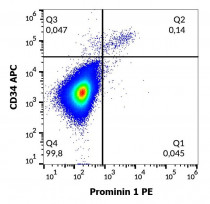ARG42349
anti-Prominin 1 antibody [293C3] (PE)
anti-Prominin 1 antibody [293C3] (PE) for Flow cytometry and Human
Overview
| Product Description | PE-conjugated Mouse Monoclonal antibody [293C3] recognizes Prominin 1 |
|---|---|
| Tested Reactivity | Hu |
| Tested Application | FACS |
| Specificity | The mouse monoclonal antibody 293C3 recognizes the extracellular epitope 2 on human CD133 (CD133/2), a 120 kDa glycoprotein of prominin family, expressed e.g. on progenitor cells. This antibody is important for identification of human renal progenitors. |
| Host | Mouse |
| Clonality | Monoclonal |
| Clone | 293C3 |
| Isotype | IgG2b |
| Target Name | Prominin 1 |
| Antigen Species | Human |
| Immunogen | Human Prominin 1. |
| Conjugation | PE |
| Alternate Names | CORD12; CD133; RP41; Antigen AC133; MCDR2; CD antigen CD133; PROML1; AC133; Prominin-like protein 1; Prominin-1; MSTP061; STGD4 |
Application Instructions
| Application Suggestion |
|
||||
|---|---|---|---|---|---|
| Application Note | * The dilutions indicate recommended starting dilutions and the optimal dilutions or concentrations should be determined by the scientist. |
Properties
| Form | Liquid |
|---|---|
| Purification | Purified |
| Buffer | PBS and 15 mM Sodium azide. |
| Preservative | 15 mM Sodium azide |
| Storage Instruction | Aliquot and store in the dark at 2-8°C. Keep protected from prolonged exposure to light. Avoid repeated freeze/thaw cycles. Suggest spin the vial prior to opening. The antibody solution should be gently mixed before use. |
| Note | For laboratory research only, not for drug, diagnostic or other use. |
Bioinformation
| Database Links | |
|---|---|
| Gene Symbol | PROM1 |
| Gene Full Name | prominin 1 |
| Background | This gene encodes a pentaspan transmembrane glycoprotein. The protein localizes to membrane protrusions and is often expressed on adult stem cells, where it is thought to function in maintaining stem cell properties by suppressing differentiation. Mutations in this gene have been shown to result in retinitis pigmentosa and Stargardt disease. Expression of this gene is also associated with several types of cancer. This gene is expressed from at least five alternative promoters that are expressed in a tissue-dependent manner. Multiple transcript variants encoding different isoforms have been found for this gene. [provided by RefSeq, Mar 2009] |
| Function | May play a role in cell differentiation, proliferation and apoptosis (PubMed:24556617). Binds cholesterol in cholesterol-containing plasma membrane microdomains and may play a role in the organization of the apical plasma membrane in epithelial cells. During early retinal development acts as a key regulator of disk morphogenesis. Involved in regulation of MAPK and Akt signaling pathways. In neuroblastoma cells suppresses cell differentiation such as neurite outgrowth in a RET-dependent manner (PubMed:20818439). [UniProt] |
| Cellular Localization | Apical cell membrane; Multi-pass membrane protein. Cell projection, microvillus membrane; Multi-pass membrane protein. Cell projection, cilium, photoreceptor outer segment. Endoplasmic reticulum. Endoplasmic reticulum-Golgi intermediate compartment. Note=Found in extracellular membrane particles in various body fluids such as cerebrospinal fluid, saliva, seminal fluid and urine. [UniProt] |
| Calculated MW | 97 kDa |
| PTM | Isoform 1 and isoform 2 are glycosylated. Acetylation at Lys-225, Lys-257 and Lys-264 by NAT8 and NAT8B may control PROM1 protein expression and its function in cell apoptosis. [UniProt] |
Images (1) Click the Picture to Zoom In






